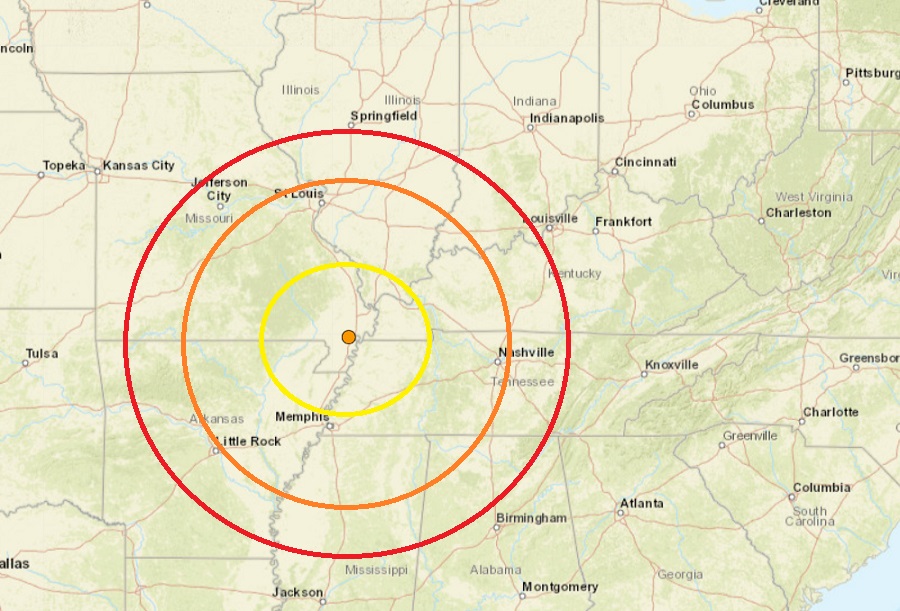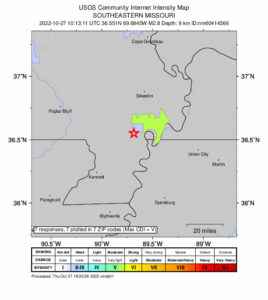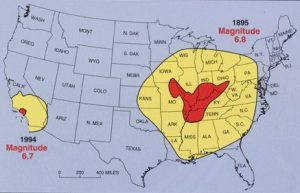
According to the USGS, strong shaking was reported after another earthquake rocked the New Madrid Seismic Zone today, the strongest earthquake to hit the area in the last 4 weeks. At 5:13 am local time, a magnitude 2.8 earthquake struck at a depth of 9 km just outside of Catron, Missouri. Using the “Did you feel it?” reporting tool on the USGS website, residents, especially those just north and east of today’s epicenter, reported strong shaking from the earthquake. USGS rates the intensity of earthquakes using Roman Numerals on a 1-10 (I-X) scale where 1 is the weakest with no shaking felt and no damage reported to 10, where shaking is extreme and damage is very heavy. USGS rated today’s New Madrid Seismic Zone (NMSZ) event a 6 or VI.


Today’s earthquake hit just a day after another earthquake rattled nearby western Tennessee. Before today, yesterday’s 2.7 magnitude event was the strongest of 20 quakes to strike the region in the last 30 days. Since the summer, earthquake volume has been up 300% above normal around the NMSZ; in addition to a high volume of earthquakes, the intensity appears to be increasing in recent days.
However, USGS cautions that the intensity and volume of earthquakes may not be a predictor for future stronger earthquakes. “Neither the USGS nor any other scientists have ever predicted a major earthquake. We do not know how, and we do not expect to know how any time in the foreseeable future,” USGS wrote in their Earthquake FAQ.
“Predictions (by non-scientists) usually start swirling around social media when something happens that is thought to be a precursor to an earthquake in the near future. The so-called precursor is often a swarm of small earthquakes, increasing amounts of radon in local water, unusual behavior of animals, increasing size of magnitudes in moderate size events, or a moderate-magnitude event rare enough to suggest that it might be a foreshock,” writes USGS.
“Unfortunately, most such precursors frequently occur without being followed by an earthquake, so a real prediction is not possible. Instead, if there is a scientific basis, a forecast might be made in probabilistic terms.”
The New Madrid Seismic Zone is home to one of the most powerful earthquakes to strike the continental United States. Over a period of many months from 1811-1812, significant earthquakes struck the area. Scientists believe more large earthquakes will strike, but aren’t sure when or where exactly within the NMSZ they’ll strike.
The NMSZ is best known for a seismic event that unfolded in 1811 and 1812. On December 16, 1811, at roughly 2:15am, a powerful 8.1 quake rocked northeast Arkansas. The earthquake was felt over much of the eastern United States, shaking people out of bed in places like New York City, Washington, DC, and Charleston, SC. The ground shook for an unbelievably long 1-3 minutes in areas hit hard by the quake, such as Nashville, TN and Louisville, KY. Ground movements were so violent near the epicenter that liquefaction of the ground was observed, with dirt and water thrown into the air by tens of feet. President James Madison and his wife Dolly felt the quake in the White House while church bells rang in Boston due to the shaking there.
From December 16, 1811 through to March of 1812, there were over 2,000 earthquakes reported in the central Midwest with 6,000-10,000 earthquakes located in the “Bootheel” of Missouri where the New Madid Seismic Zone is centered.

The second principal shock, a magnitude 7.8, occurred in Missouri weeks later on January 23, 1812, and the third, a 8.8, struck on February 7, 1812, along the Reelfoot fault in Missouri and Tennessee.
The main earthquakes and the intense aftershocks created significant damage and some loss of life, although lack of scientific tools and news gathering of that era weren’t able to capture the full magnitude of what had actually happened. Beyond shaking, the quakes also were responsible for triggering unusual natural phenomena in the area: earthquake lights, seismically heated water, and earthquake smog.
Due to the geological construct of soil and rocks in the region, earthquakes in this part of the country can be far more impactful than quakes in the U.S. West. The magnitude 6.8 event in the NMSZ in 1895 was felt over a far greater area than the 1994 Los Angeles earthquake.